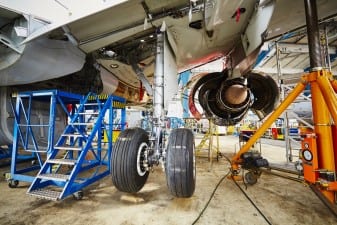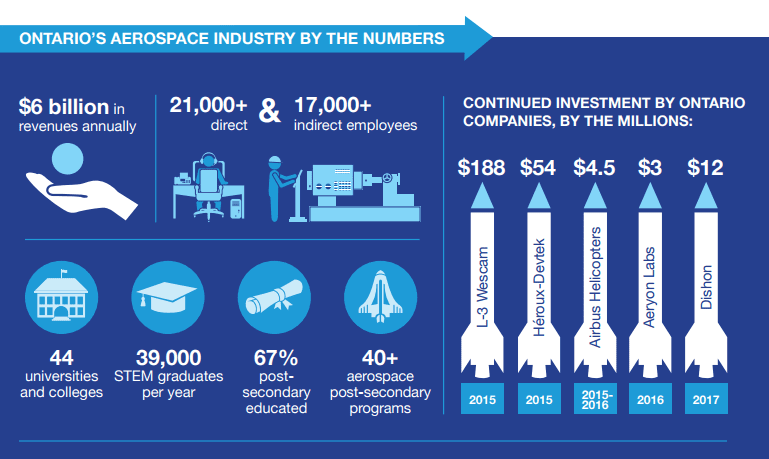Soaring to New Heights: Ontario Aerospace Industry Strengths and Challenges

For a several years, Ontario’s aerospace and aviation sector has experienced continuous growth despite emerging industry barriers, such as access to skilled labour. The province is home to some of the most prestigious aerospace companies; currently, the majority of the top 25 Canadian aerospace businesses are located in Ontario.
The industry’s outlook is promising, however, there are still challenges that businesses face when trying to grow and prosper within this sector.
In June, Aviation Week Network reported that despite stable aerospace activity, some companies are struggling to expand and become more profitable. The industry has seen modest growth, however much of this is attributed to recent business acquisitions. Now, industry leaders are concerned whether thriving companies will be able to continue at a high rate of production to sustain the sector’s growth and development.
Ontario Aerospace Industry Outlook for 2017

Ontario aerospace companies account for over 30% of all aerospace research and development activities in Canada. For nearly a decade, aerospace research projects have resulted in notable innovations, such as the development and repair of landing gear and actuation systems.
Every year, innovative technologies, products, and processes help accelerate the industry’s growth and success. Some recent examples include:
- Bombardier: Successfully reduced production rates for its Q400 regional airliner by approximately 20-25% per year.
- Cyclone Manufacturing: For the past 6 years, the company has tripled in size and has experienced a growth rate of 20% per year.
- L3 WESCAM: In May 2017, the company launched MatriX ISR system kits for fixed- and rotary-wing aircraft, which combine commercial technologies that improve mission capabilities.
In 2016, Ontario aerospace companies contributed over $6 billion in annual revenues.
However, technology adoption and access to skilled labour continues to be a challenge for some manufacturers and suppliers operating in this space. Despite these market challenges, Ontario continues to be Canada’s leader in aerospace and aviation.
Related Post: Clear Skies Ahead: Ontario’s Aerospace Industry is Growing Stronger
Ontario Government Funding Programs for Aerospace Manufacturing Projects
The Government of Ontario is committed to supporting continuous growth and development initiatives across the province. Ontario small business grants can be used to support and accelerate a range of strategic projects. Some examples include:
- Hiring Grants: Up to 50% of a new hire’s wages for a period of 4-12 months, to a maximum of $13,500-$20,000 to reduce the cost of hiring and mentoring recent post-secondary graduates.
- Training Grants: Up to 66-83% coverage of third-party training costs (maximum $10,000 per trainee) to enhance your workforce by upskilling new and existing employees.
- Collaborative Research Grants: Multiple programs exist to cover up to 50-75% in research-related costs to a maximum of $25k-250M to offset industry-led exploratory R&D projects that demonstrate innovation and support wide-scale industry improvements.
- Energy Efficiency Grants: Up to 50% coverage to a maximum of $500,000 per facility and/or a maximum of $1.5M for upgrades to up to five facilities. Funding can be used to purchase equipment and adopt technologies that increase productivity, improve energy efficiency, and reduce greenhouse gas (GHG) emissions.
- Export Expansion Grants: Up to 50% coverage of export marketing activities to a maximum funding amount of $30,000-99,999 per application to reduce the cost of trade show exhibiting, travel costs, and market research and development.
Find Ontario Government Grants for Your Business Projects
Ontario business owners and executives can access a range of Ontario government funding programs to support R&D, business expansion, hiring and training, as well as capital investment projects. There are key differences between types of funding that businesses should be aware of prior to aligning projects with specific grants and loans.
Download Mentor Works’ Comparing Funding Types slide deck to compare the different types of funding programs that are available for Ontario-based businesses.
Recent Aerospace and Aviation Industry News:
- Firan Technology Group Corporation Receives Over $7M to Improve Canada’s Aerospace Industry
- Aerospace Regional Recovery Initiative: $250M to Support Canada’s Aerospace Sector
- Two Government Funding Programs Supporting Canada’s Regional Aviation Sector
- MDA LaunchPad: Technology Development Collaboration Opportunity
- $13M in Innovation Funding for the Canadian Aerospace Industry

